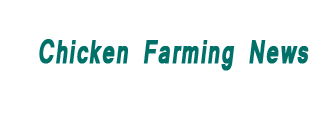Broiler Breeding Technology in Chicken Farm
More and more farmers are beginning to develop the breeding industry. Large-scale breeding of chickens requires the use of Poultry Rearing Equipment, such as broiler cages, dung removal equipment and feeding equipment. However, in addition to these breeding equipment, if you want to raise chickens well and bring economic benefits to yourself, you still need certain breeding technology. The following are the key points of broiler breeding technology.
First of all, large-scale farming requires a farm. We need to know where is the best place for chicken farm construction. The selection of chicken farm site is directly related to the epidemic prevention status and economic benefits of chicken farms. According to the size of the breeding scale and the resource conditions, it is necessary to have a clear view of the convenient transportation of the chicken coop, sufficient water resources and guarantee the power supply. Electricity is required for lighting, water supply, temperature supply, ventilation, etc. in the chicken farm, so the chicken farm requires sufficient power supply. Environmental conditions are good and there is room for development.
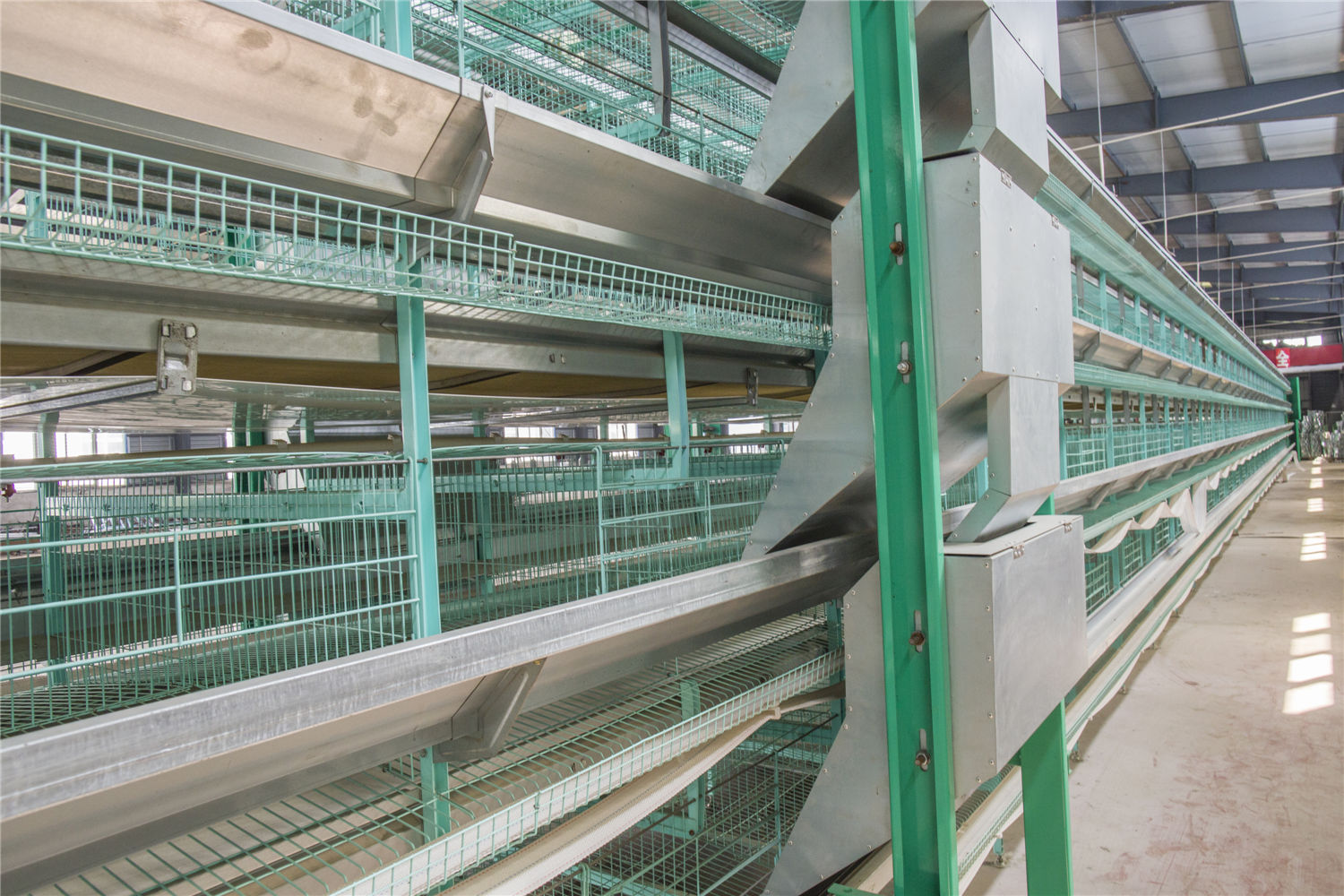
Chicken coops are places where chickens live healthily. When building chicken coops, attention should be paid to the performance of heat preservation, heat insulation, ventilation and lighting, moisture prevention, ease of production and operation, disinfection and epidemic prevention, etc. At present, there are many types of buildings in chicken coops, which can be divided into two categories: open type and closed type according to different building structures and performances. Closed henhouse is also called windowless henhouse, because it is relatively closed to the outside world, has the function of temperature isolation and shading, and can adjust and control the internal environment of the henhouse. It has greater advantages than open henhouse, but it has high cost and large infrastructure investment.
Broilers for meat are more suitable for high-density feeding, and the feeding amount depends on the effective feeding area of the chicken house and the appropriate feeding density in battery cage for chickens. However, in actual production, the amount of breeding is restricted by many factors. The first is the number of breeders, the second is the feed supply capacity and the source of chickens, and the third is the area of chicken houses. Under the condition that there is no problem with the first two, the feeding amount depends on the area of the chicken coop.
There are two types of ventilation in chicken coops: mechanical ventilation and natural ventilation. There are mainly two types of mechanical ventilation in closed chicken coops, namely, horizontal ventilation and vertical ventilation. These are the key points of raising chickens in the poultry house, hoping to help farmers build a suitable chicken farm.
Broiler feeding management points of spring
1. Disinfection
The chicks are thoroughly cleaned and disinfected 5 days before entering the site, avoiding corrosive disinfectant such as caustic soda to prevent equipment damage, then fumigation with formaldehyde, and sealing the doors and windows. After 24 hours, the window is ventilated. Personnel must be strictly disinfected to avoid destroying the disinfection effect. The trough and drinking fountains are cleaned and disinfected. After the chicks arrive, the ground is cleaned every day to reduce the stimulation of the respiratory tract by dust and chicken fluff, and the chickens should be disinfected every other day. Several disinfectants can be used alternately, and the vaccination period should be avoided for more than 24 hours.
2. Temperature
There is a temperature difference between the three-layer chicken battery cages in the upper, middle and lower layers, and the lower the outdoor temperature, the greater the temperature difference. Brooding is generally at the highest level, because the highest temperature is the highest, which is conducive to saving heat. The chicks enter the field on the first day, the temperature is controlled at 33 ~ 34 ° C, but also according to the state of the chicks to adjust the temperature. When the temperature is suitable, the flocks are evenly distributed, active and active, and the appetite is strong; when the temperature is low, the neck is constricted and concentrated to the heat source. Squeeze each other, the body trembles; when the temperature is too high, the amount of drinking water increases, the appetite decreases, the breathing speeds up, and the neck feathers are soaked. In the first week, the temperature dropped to 30~C, and then decreased by 2°C every week. The density of three-dimensional culture was large, which was 1~2°C lower than the flattening temperature. It should avoid the heat stress and the food intake decreased.
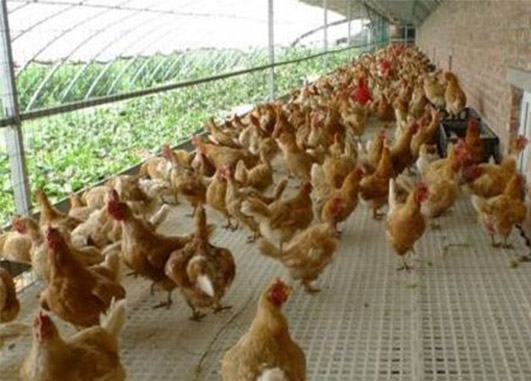
3. Grouping
Three-dimensional cultured broiler chickens use the whole sports chicks. When the chicks are too dense, they should be grouped in time to ensure that the chicks are evenly weighted. The first group is usually 12 to 16 days old, and the group is too early. Because the body size is too small, it is easy to grow in the cage gap. Drilling also wastes space and wastes energy. The second grouping, at 25 to 28 days of age, adopts the principle of “remaining weak and not staying strong” when grouping, and the important young chicks are placed in the lower layer, and the weak chicks are left behind. In summer, due to high temperature, it can be properly caged in advance. In winter, due to the large temperature difference between the upper and lower layers of the cage, the poultry battery cages time can be appropriately postponed, and one more in the lower cage to reduce the temperature difference between the upper and lower layers.
4. Ventilation
The key to successful aquaculture is ventilation, reasonable ventilation, elimination of harmful gases, temperature control, and reduction of ascites, chronic respiratory diseases and colibacillosis. The density of the three-dimensional farming unit is large, so ventilation is more important. Within 24 hours after entering the farm, the chicks can be ventilated due to the large space of the whole sports. As the age of the chicken increases, the ventilation volume is gradually increased, and the position and size of the air inlet are adjusted. Day, night, cloudy, sunny, spring, summer, autumn and winter. It is necessary to constantly adjust in a timely manner to achieve the feeling of no smell, no glare, no oxygen deficiency and more comfort in the house, to create a good growth space for the chickens, enhance the body's disease resistance and reduce the occurrence of diseases.
Precautions for purchasing broiler cages in Nigeria
Many farmers are purchasing broiler cages. Pay attention to some purchase matters.
First of all, we must know the distance between the iron bars of the broiler cage. This is very important for broiler cages. A reasonable spacing is 2.5cm*5cm. Some farmers may think that the size of the broiler chickens is relatively large, and the spacing can be increased. This idea is wrong. Conditional farmers can also lay a plastic net on the bottom of the broiler cage that is consistent with the cage eye. This can not only buffer the strength of the eggs hitting the net and reduce the rate of broken eggs, but also prevent some diseases.
The design angle of the bottom of the broiler cage. The angle of the broiler cage must be accurate. The egg cannot be rolled out in time at a small angle, and it is trampled by the chicken. A large angle may cause the egg to break, and the general angle is maintained at seven to eight degrees.
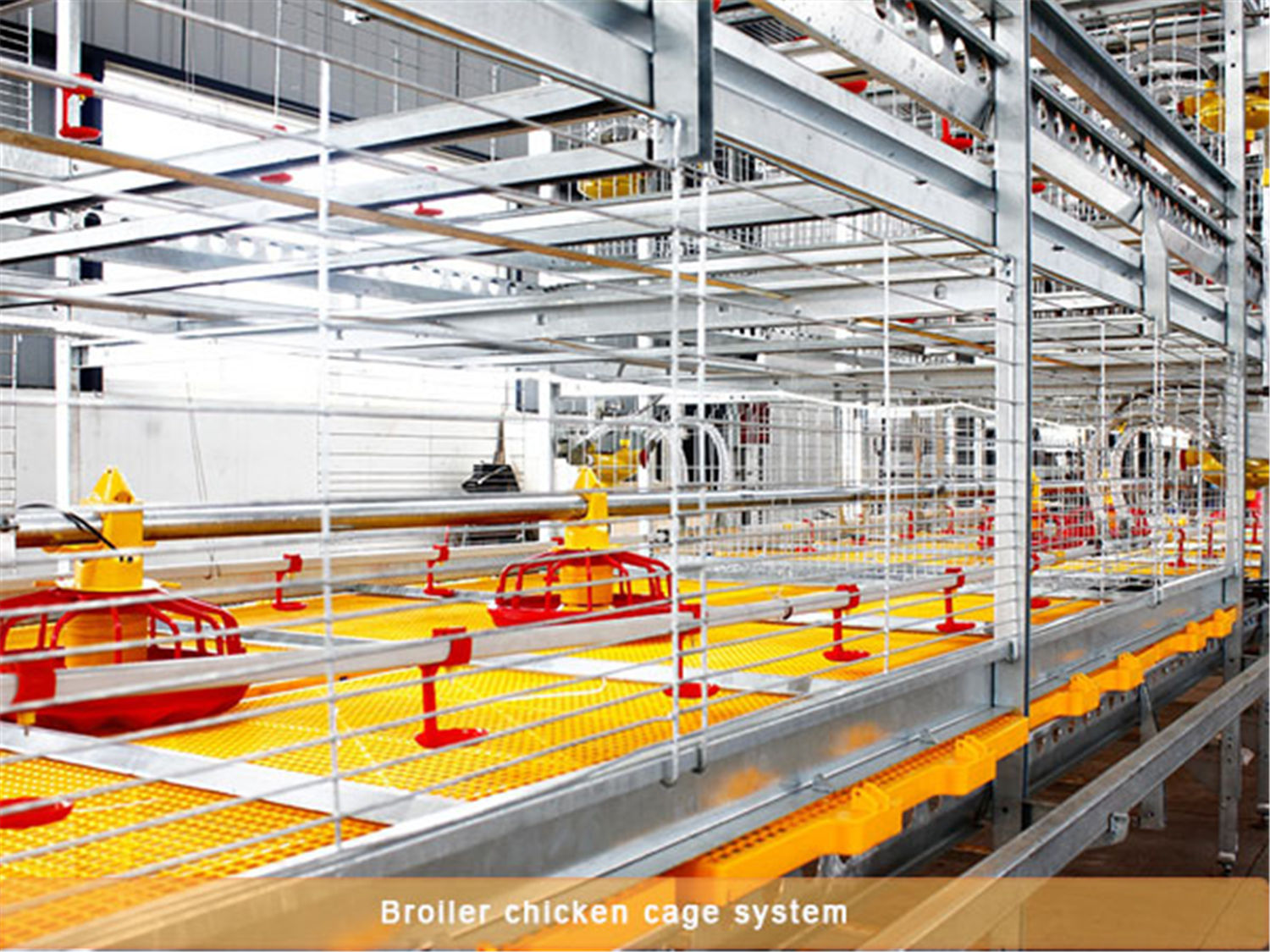
Pay attention to the connection between the broiler cage and the bottom of the cage net. I must remind you that there are farmers, and you can't leave a big gap here. Because there are more eggs here. You must pay attention to this detail when buying a broiler cage.
The choice of materials for the chicken cage is very particular. It is necessary to choose suitable and tough materials. The diameter of the iron wire at the bottom of the cage is about 2 mm. The egg breaking rate is very small. The larger the diameter of the iron wire, the easier it is to cause broken eggs.
Due to the high density of broiler cages, it is not conducive to observe the situation in the flock. Especially in the brooding period, it is more obvious, so it is necessary to carefully observe the cage around the cage carefully. Prevent the abnormal situation in the flock from being discovered and dealt with in time. When the chicks are just transferred to the rearing cage. Due to the new environment, the chickens will be temporarily uneasy. The chickens that ran out of the cage should be caught in the cage in time, and the chickens should be carefully checked for damage and whether all the chickens can drink water in time.
In addition, in daily management, we should carefully observe the chickens every time, and be well aware of the chickens’ feeding, drinking, feces, mental state, etc., timely prevent diseases, strengthen management, and reduce economic losses.These are the precautions for purchasing broiler cages in Nigeria
How do farmers disinfect broiler breeding equipment?
While broiler breeding equipment is convenient for breeding, there are also sanitation issues that need to be paid attention to. A good chicken house environment provides a better living space for chickens. This is also conducive to the healthy growth of chickens.
The first is to clean the chicken coop. Cleaning the chicken house requires removing the feces and debris inside and outside the chicken house. The feed that the chickens have not eaten in the trough also needs to be cleaned out. Then clean the trough with water.
Next, the chicken farmers must carry out an all-round cleaning of the chicken house. Poultry chicken cages, chicken manure board and other equipment and ceiling, chicken coop floor. Note that farmers must protect live equipment before cleaning to avoid accidents.

The third step. Equipment that can be moved should be removed from the house for disinfection. Expose it in the sun and put it back into the chicken coop one by one.
Fourth, the most common disinfection method used by farmers is to spray chemicals. This is the best way to eliminate pathogens in the chicken house. Farmers should pay attention to all aspects when spraying.
After the above steps are completed. Farmers can open all the entrances and exits and vents of the chicken coop. Let the chicken house ventilate for about ten days. The bacteria are further eliminated by keeping the chicken coop dry.
The above are the methods and precautions for disinfection of the shared chicken coop.
How is the prospect of raising chicken in the countryside?
How is the prospect of raising chicken in the countryside? How can rural chicken raise sales? In rural areas, every family in the yard is accustomed to raising a few chickens. Because chickens are relatively good for poultry, many farmers directly use chickens as their main business and set up chicken farms. The first step in raising chickens to make money is to solve the problem of marketing. Some chicken farmers have good chickens, but they can't find a good market and they don't have a large price.
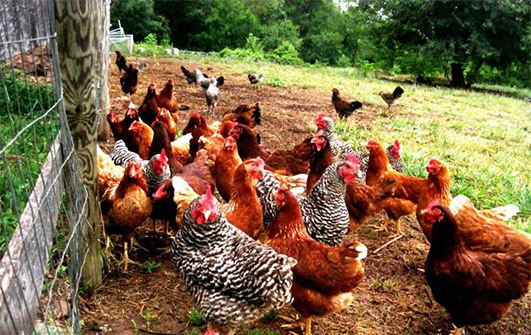
Native Chicken Breeding Has a Bright Future
As consumers are increasingly demanding food quality, consumers have chosen green and natural ways to grow and raise farm products. Green consumption has become a trend. In the case of loose-breeding chickens, many eco-random chicken farms have emerged throughout the country, and various chickens such as pheasants, black-bone chickens, Taishan chickens, reed chickens, and northern Jiangsu grass chickens have been free-ranged in accordance with natural methods. The average chicken meat is 1-2 times, and the price of the soil eggs is several times that of ordinary eggs.
Characteristics and dimensions of three tiers of broiler cages
In the past, farmers raised broilers in flat greenhouses, and the number of breeding was small. It has been difficult to meet the market demand for chicken product quality. Moreover, the simple raising equipment may cause the disease to be difficult to control, which will inevitably affect the meat output of broilers. However, the broiler cage raising equipment vigorously promoted by the breeding industry can implement automatic fecal removal, so that the broiler is separated from the fecal sewage, achieving less incidence, fast growth, good quality and good benefits. Now the author will talk about the characteristics and dimensions of broiler cages.
Characteristics of broiler cages:
1. The stacked broiler cages produced by high-quality poultry equipment suppliers use a full set of hot-dip galvanizing technology, which is corrosion-resistant and has a service life of more than 20 years.
2. The material of Q235 has great elasticity and is not easy to bend.
3. The high-density breeding saves land, which is about 70% less than the stepped land.
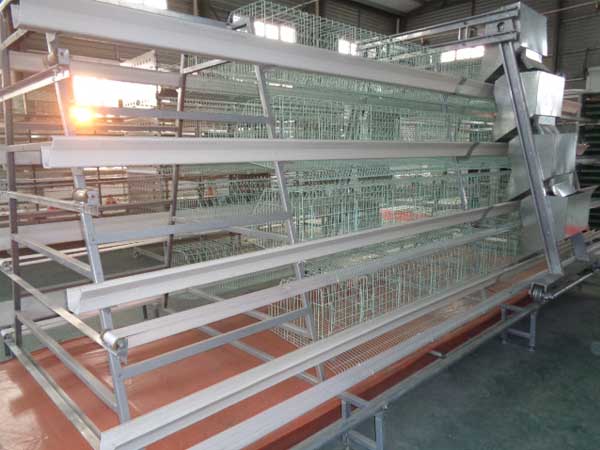
4. Centralized management, save energy and resources, adopt advanced ventilation system, lighting system and automatic control system to fully save energy consumption and improve labor productivity.
5. Save space and increase the feeding density to more than 60 animals/m2.
6. The unique cage door design effectively prevents the chicken from shaking its head up and down when it is eating.
7. The use of conveyor belt to clean the manure to dry the chicken manure into granules, reduce environmental pollution, and high reuse rate of chicken manure.
8. Eco-environmental protection is the most ideal feeding equipment for green chicken and environmental protection egg products.
Broiler cage size:
The cascading broiler cages have three layers and two doors. Each group has a length of 140cm, each group spans 200cm, the number of units is 6, the unit length is 70cm, the unit depth is 70cm, the cage height is 38cm, and the feeding amount is 60.
Stacked broiler cages with four layers and two doors, each group length 140cm, each group span 200cm, unit number 8, unit number 70cm, unit depth 70cm, cage height 38cm, feeding capacity 80.
Each poultry farming equipment supplier provides different sizes of chicken cages, so when buying, you only need to buy according to your own needs, and you don't need to be constrained by the size of the chicken cage.
Precautions for automatic feeders
The production and use of automatic feeders greatly solve the problems of large and medium-sized farmers who are difficult to feed the chickens in chicken battery cages, have a long time and labor intensity, and effectively improve the work efficiency. Then the automatic feeder should pay attention to the use. What are the matters?
What are the precautions for using the automatic feeder?
First, pay attention to timely inspection. The inspection is divided into three parts: the top of the feeder, the belt, and the motor. The automatic feeding machine can not place heavy objects on the top, and check whether the belt is loose. The main part of the feeding machine is the motor and the geared motor. Therefore, pay special attention to whether the motor has abnormal conditions, and if necessary, handle it in time.
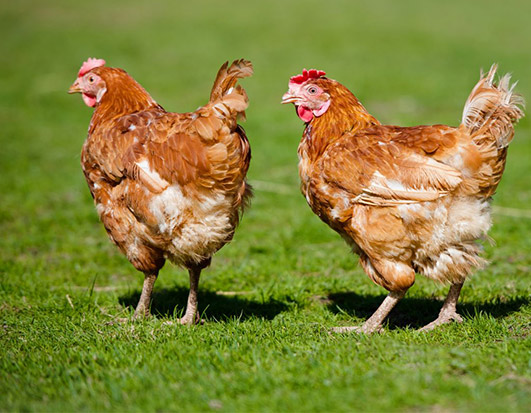
Second, we must pay attention to clean up. Because the dust will be generated during the operation of the feeder due to the production of feed, if the dust remains on the machine, it will cause dust in the control box of the feeder, which may eventually lead to short circuit and affect the machine. Therefore, when using, remember to regularly clean the feeder.
Third, keep the lubrication between the feeders. If there is no lubrication between the gear chains, the components inside the feeder will wear out, which will affect the working effect and efficiency.
Broiler cage manufacturers tell how to disinfect chickens
For major chicken farmers who use Fully automatic poultry farming equipment for chicken, the disinfection of chickens is an indispensable part of the breeding process. Reasonable disinfection can reduce the prevalence of chickens and strengthen the environmental sanitation of the chicken coop. How to disinfect chickens? , What are the steps of disinfection? Broiler cage manufacturer Dajia Machinery summarized the key steps of disinfection of chickens, and now I will share them with farmers.
Cleaning the chicken house: Before disinfection, in order to achieve a better disinfection effect, farmers need to clean the chicken house first, because cleaning can clean the dust, feces, residual feed and other dirt on the surface of the chicken house. It can kill the dirt and bacterial pathogenic microorganisms in the deeper part of the chicken house during disinfection, and achieve a better disinfection effect.
The second step of disinfection is to wash the chicken house: For farmers who disinfect the empty chicken house, they should also pay attention to washing the chicken house after cleaning the chicken house. This is to clean the chicken house thoroughly and use the disinfectant solution. To play a good effect, thoroughly scrubbing the chicken house can ensure the effectiveness of the disinfectant. Therefore, after the dirt on the ground is soaked and softened in water, it should be scrubbed with a hard brush. It is better to use a power spray pump to scrub it at high pressure.
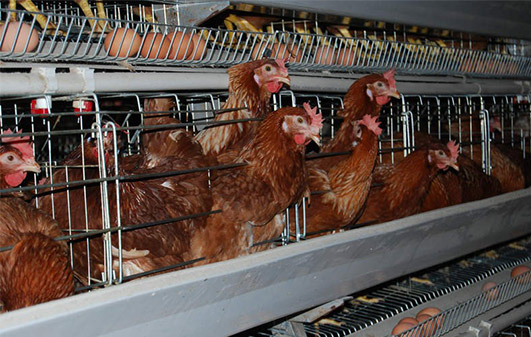
The third step of disinfection is to wait for the chicken house to dry: if the chicken house of the farmer is washed, it cannot be disinfected immediately. You need to put the chicken house aside for a few days and wait for it to be disinfected after drying. Otherwise, disinfect with water. Who will dilute it and fail to achieve a good disinfection effect.
The fourth step of disinfection is to prepare disinfectant drugs: there are many methods of disinfection. After the farmers choose the disinfection method, they must prepare the disinfectant drugs according to the proportions in the disinfectant instructions.
The fifth step of disinfection: disinfection: After the above work is completed, the farmers will start disinfection. When disinfecting, pay attention to the comprehensiveness of disinfection, and cover all corners of the chicken house, such as the roof, ceiling, walls, and fixings. Facilities, grounds, etc. must be properly disinfected so that better results can be achieved. Be careful not to miss the blocked parts.
The above is the steps of how to disinfect chicken raised by broiler cage manufacturers for farmers. I hope that the above description can bring some help to farmers.
More...
Method of mixing feed for broiler chicken breeding in broiler cage
In the process of developing poultry farming projects in broiler chicken cages, it is hoped that the nutrients contained in each feed that chickens eat are balanced. Otherwise, the flock will suffer from malnutrition, nutrient deficiency or poisoning. Therefore, the feeding formula of the chickens in the automatic broiler cage can be stirred evenly to meet the nutritional needs of the chickens.
There are two methods of feed mechanical mixing and manual mixing. As long as it is used properly, satisfactory results can be obtained.
- The broiler cage feed is mechanically mixed, using a broiler cage mixer. Commonly used broiler cage mixers are vertical and horizontal.
The vertical mixer is suitable for mixing powdered feed with a water content of less than 14%. If the water content is too high, it is difficult to mix evenly. This kind of broiler cage mixer requires small power and is easy to maintain, but the mixing time is long (generally 10-20 minutes per batch), which is suitable for chicken farmers and small chicken farms.
The horizontal mixer can mix the broiler cage feed evenly in areas with relatively humid climates or when strong viscous ingredients (such as grease) are added to the feed. The machine has a short mixing time, 3-4 minutes per batch, and is mainly used in some feed processing plants. No matter what kind of broiler cage mixer is used, in order to stir evenly, the charging amount must be appropriate. Too much or too little charging cannot be uniform. Generally, 60%-80% of the capacity is suitable for charging. The mixing time is also an important factor related to the mixing quality. The mixing time is too short, but it is not the longer the better. If the mixing is too long, the feed will be mixed evenly and then cause stratification due to excessive mixing.

- Manual mixing is the main method of feed mixing when raising chickens at home.
When mixing, be careful and patient to prevent some trace ingredients from clumping and agglomerating. Uneven mixing will affect the feeding effect.
When manually mixing chickens in battery cages for broiler, special attention should be paid to some trace components that account for a small proportion in the diet but will seriously affect the feeding effect. Such as salt and various additives. If the mixing is not uniform, the feeding effect will be affected in the light, and the chickens will be poisoned or even die in serious cases.
For such trace components, the broiler cage feed must be fully crushed when mixing, and there should be no agglomeration. The agglomerates may be poisoned after being eaten by the chickens. Secondly, due to the small amount of such ingredients, they cannot be directly added to bulk feed for mixing, but should be pre-mixed.
The method is: take 10%-20% of the concentrate (which is a large proportion of energy feed, such as corn) as a carrier, and stack it in addition, and press the feed of the next shovel on the feed put down by the previous shovel, that is, go all the way to the feed. The feed is placed on the top, and the feed flows around the center point to form a cone, so that various broiler cage feeds have the opportunity to mix. Repeat this 3-4 times to achieve the purpose of mixing evenly, and the premix is ready. This premix is then added to the whole feed and mixed 3-4 times in the same way to achieve the purpose.
Do you Know What’s the new Concept of Broiler Rearing Management?
With the progress of the times and the development of science and technology, the genetic breeding technology of broilers has been greatly improved, and the nutritional formulation of chicken feed has also undergone new changes. Broiler breeds are constantly being optimized, and the feeding and management viewpoints of broiler chickens are no longer practical. The broiler breeders at this time need to understand some new ideas for the early feeding and management of broilers.
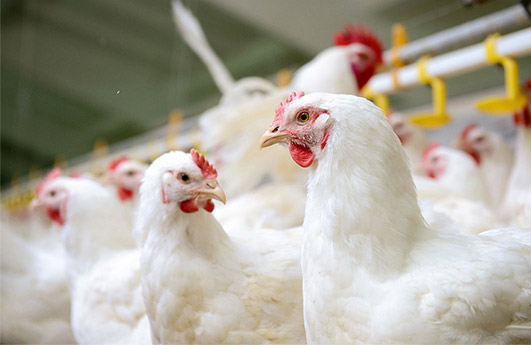
Do a good job of early feeding chicks, so that the chicks get even and good development in the first week. Changing the way that chickens were fed before drinking water for a period of time before they were fed will become better when the chicks arrive. Change the practice of distributing drinking fountains according to the number of chickens in the past, and increase the number of drinking fountains accordingly so that the chicks can easily find the water in the column after entering the house. If the chicks do not use the trays within the first day of arrival, use clean plastic cloths on the net or spread clean and hard papers to spread the material on the chicks for feeding. The effect is much better than using the trays alone.
